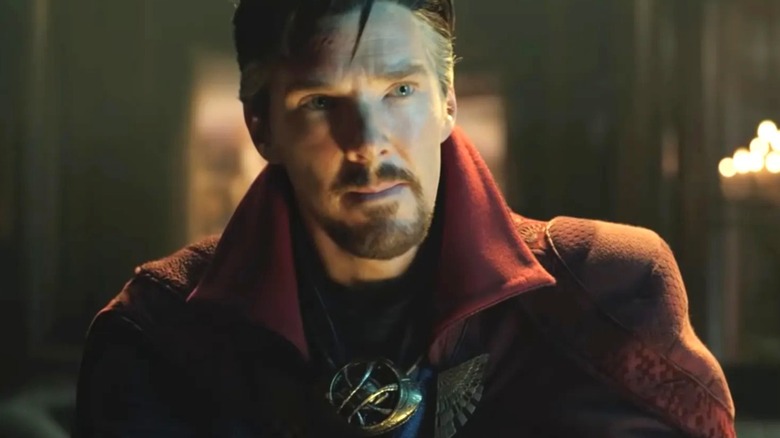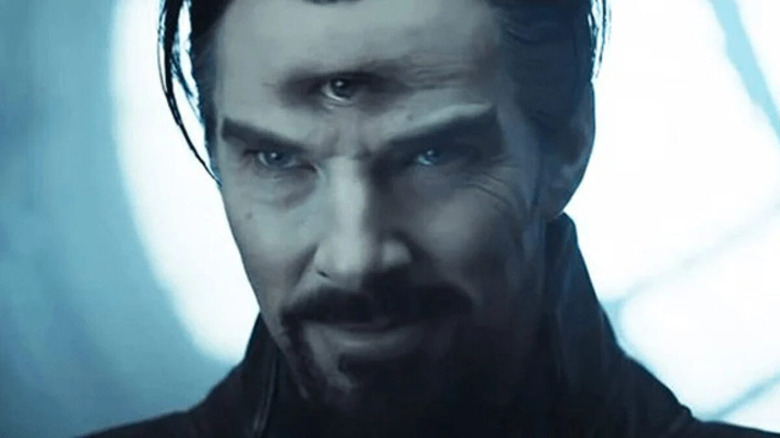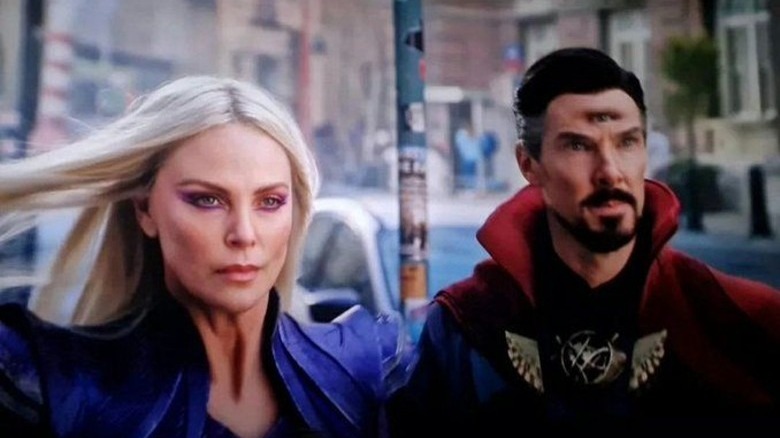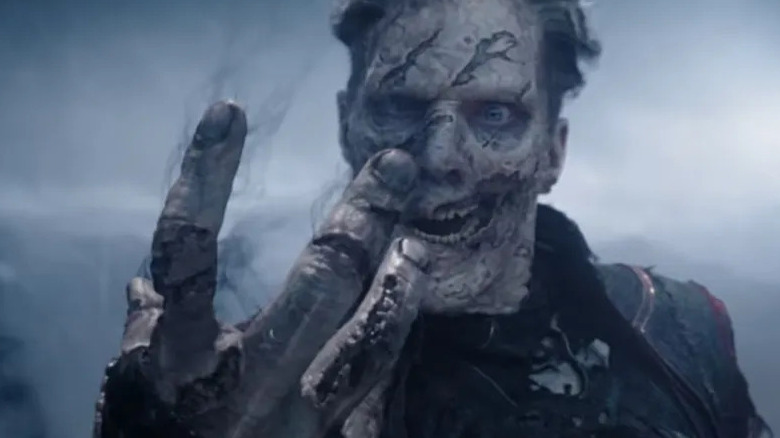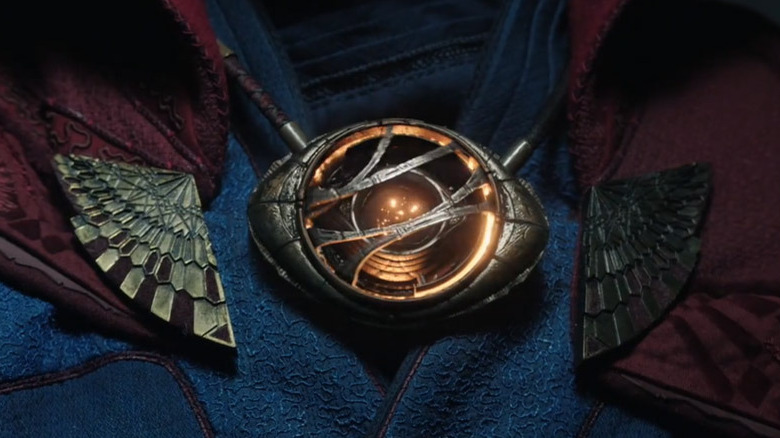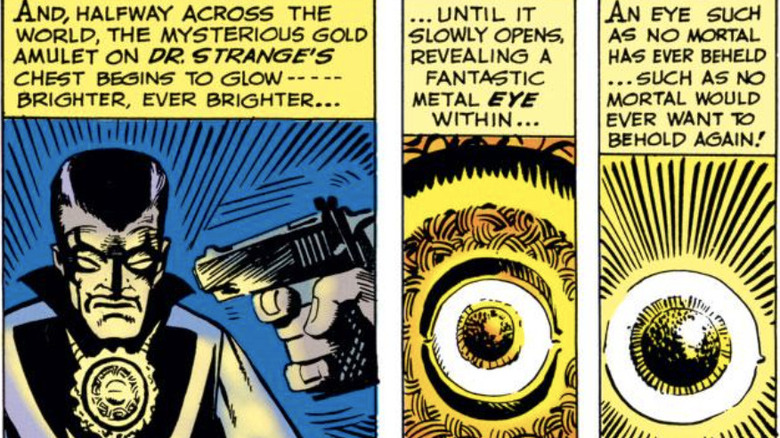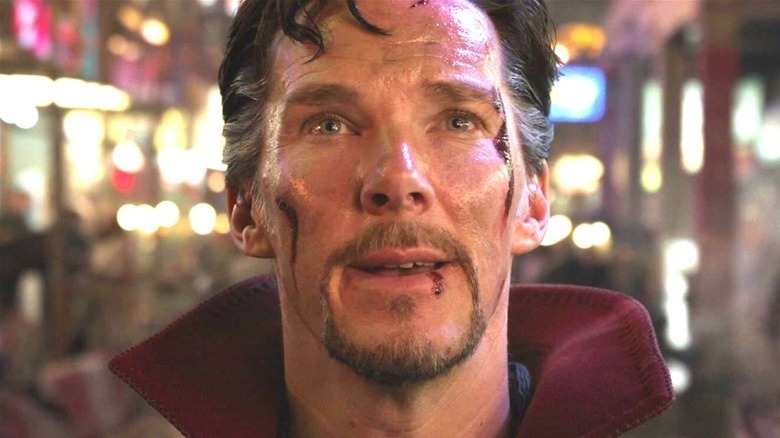Doctor Strange's Third Eye Explained
Considering its relatively short (by MCU standards) two-hour runtime, "Doctor Strange in the Multiverse of Madness" is packed full of trippy and sometimes disturbing visuals, as well as numerous references to Marvel Comics. One development that falls into both of those categories is the third eye that shows up smack dab in the center of the forehead of not one but two versions of Doctor Strange (both played by Benedict Cumberbatch). So what's going on with that off-putting extra peeper? The film makes some allusions to what the eye might be, but it doesn't go out of its way to give audiences an explanation.
Though the CGI with which the eye is rendered might not have been very compelling in the opinions of Doctor Strange's many fans, as a piece of plot and character development, it has enormous implications for the franchise going forward. We don't know exactly how Marvel Studios will use the eye or interpret its powers and purpose in future installments, but from source material and context clues, we can make some educated guesses. This is the story behind that third eye (which dates all the way back to the 1960s): what it is, what it does, how Doctor Strange ended up with it, and how it could affect the future of the Marvel Cinematic Universe.
Sinister Strange has the third eye first
Before we get to the big, climactic battle of "Doctor Strange in the Multiverse of Madness," Stephen becomes stranded in a universe that's collapsing in on itself where a variant known as Sinister Strange is isolated in a Sanctum tower with the evil book called the Darkhold. At first, our Strange doesn't realize that this Strange has gone to the dark side. He and Christine Palmer (Rachel McAdams) initially plan to ask for help defeating Wanda Maximoff (Elizabeth Olsen), until Sinister Strange grasps the Darkhold and a third eye appears on his forehead.
During their confrontation, Stephen learns that Sinister Strange used the Darkhold to dreamwalk, and that it corrupted him to the point that he became obsessed with finding a reality in which he ended up with Christine, who Strange loves in every universe. That reality doesn't exist anywhere in the multiverse, however, and Sinister Strange confesses that in his failed quest, he killed numerous Strange variants with whom he came into contact. One of the film's most bizarre and compelling sequences ensues as Doctor Strange fights Sinister Strange by magically weaponizing musical notes. Our Strange eventually wins out, using a high note to knock Sinister Strange out of a window and impaling him on a fence post.
Stephen then takes command of the Darkhold and, with Christine protecting his body, uses it to dreamwalk into his own corpse so that he and America Chavez can fight the Scarlet Witch.
It appears on Doctor Strange's forehead in a cliffhanger
After Doctor Strange defers to America Chavez (Xochitl Gomez) and her still somewhat undefined powers, the multiverse-hopping teen defeats the Scarlet Witch by showing her the heartbreaking truth of what would happen if she actually tried to coexist with her twins in another universe. With all worlds saved (for now), the film ends with Strange calmly attempting to cross an intersection — only to be suddenly forced to his knees by what seems to be a massive headache. A moment later, a third eye manifests hideously on his face, and in true Sam Raimi fashion, the movie cuts to the credits as Strange screams in horror.
The eye then comes back for a brief encore in a mid-credits scene when Clea (Charlize Theron), a mightily powerful character from the comics, makes her MCU debut, bursting into Strange's reality. She tells him that an incursion is destroying another universe and that they are going to fix it, and the eye appears again as Clea opens a portal and guides Strange through it. We don't know for sure how much time has passed in between the end of the movie and the mid-credits stinger, but the fact that the two scenes take place in similar (if not identical) locations suggests that Strange grew accustomed to that third eye fairly quickly. Whether he's figured out why it's there (let alone what it does and whether or not he can control it) is another story for another film.
The eye might have something to do with the Darkhold...
When Doctor Strange faces the Illuminati, the council explains that accessing the Darkhold's power comes at a great cost ... even if one has good intentions, as their Strange did when he used it to defeat Thanos. Sinister Strange later reinforces this idea. Since it appears on Stephen's face only after he's used the Darkhold in forbidden fashion (to puppeteer his own multiversal zombie), the third eye could very well be the price he paid for victory. After all, as far as we know, no one is immune to the corrosive effects of the Darkhold's magic — Wanda has clearly been affected. She made some difficult-to-defend choices in "WandaVision," but things really took a turn once she had her hands on the Darkhold. In "Doctor Strange in the Multiverse of Madness," she brutally dispatches anyone who stands in her way, even as she nonsensically assures her variant children that she'd never hurt anybody.
Of course, Wanda doesn't have a third eye on her forehead, despite considerable time spent with the book. This might be because she was its intended user (there's a statue of her on Mount Wundagore) or because she's a Nexus Being. Or maybe the onset of a third eye is completely unrelated to the Darkhold. Sinister Strange could've come by the eye some other way — for example, it's possible he absorbed the ability from one of the Stranges he murdered while dreamwalking.
...but it's probably a manifestation of the Eye of Agamotto
Though it's still possible Marvel Studios will tie the Darkhold into their reasoning for Doctor Strange's new third eye, a more likely explanation is that he's leveling up. Remember, every universe's Darkhold has been destroyed at the end of "Doctor Strange in the Multiverse of Madness," so it's doubtful that the book has any lingering influence over him. He also proved himself to be more pure of heart than his variant counterparts when he alone preserved America Chavez's life.
The eye probably has more to do with the amulet Strange wears around his neck. That chunky necklace is a magical relic called the Eye of Agamotto (or the Amulet of Agamotto; the eye is the magic inside), introduced in the first "Doctor Strange" film. It used to house the Time Stone, which gave Strange the ability to manipulate time and see various future probabilities until Thanos destroyed it. Doctor Strange has refurbished the relic itself, but there's no green rock in its center anymore.
No matter; the Eye of Agamotto is plenty powerful on its own. In Marvel Comics, it's named after Agamotto, one of three members of the Vishanti and the very first Sorcerer Supreme. Notably, Wong and not Strange currently holds that title, but important relics have chosen a lower-ranking Strange before based on his talent for mysticism and his readiness to take on certain foes. In this instance, his old magical item's new superpower may have chosen him, and this physical manifestation of the Eye of Agamotto could mean Doctor Strange is ready to take on even more dangerous adversaries in the second half of Phase Four.
In the comics, it's a force for good
Along with the Cloak of Levitation, the Amulet of Agamotto is one of Doctor Strange's most frequently relied-upon accessories in the comics, where it sometimes produces an actual third eye on the sorcerer's forehead. It was introduced in the same issue as Strange himself, 1963's "Strange Tales #110," which featured the character's five-page origin story. The amulet's design is loosely based on the All Seeing Eye of Buddha, a Nepalese symbol that's still worn as a pendant today.
In print form, the physical manifestation of the Eye of Agamotto isn't necessarily anything for Doctor Strange to be worried about. It's sometimes referred to as the Eye of Truth, as it often manifests more like a blinding light than an actual eyeball and socket. In fact, in contrast to the theory that the eye is a dark mark, its pure light wards off evil in the comics. This force for good gives Strange the very helpful ability to see what really is, and it can let him into the minds of others to read their true intentions. It can also break illusions and reveal disguises, and control time and space, giving Strange the power to see into the past and the future and travel to different realities and dimensions.
As we see Doctor Strange heading into that cosmic portal with his third eye open, there's a very good chance he'll need it to take on whatever threat awaits him next.
Here's what it could mean for the MCU's future
Speaking of what comes next, the Eye of Agamotto's particular usefulness and Doctor Strange's particular stature among the current Avengers indicates that the MCU could be headed in some exciting directions — even if "Doctor Strange in the Multiverse of Madness" didn't resolve Phase Four's multiverse plot as many expected. After the events of "Loki" and that mid-credits stinger, time-traveling and portal-jumping abilities could certainly be valuable. However, of much more consequence would be the eye's powers of clarity and revelation.
We know that a new "Secret Invasion" Disney+ series is in the works that'll involve Nick Fury and the shape-shifting alien Skrulls. Though the MCU is sympathetic to them at the moment, the all-seeing eye's ability to deduce the identity of Skrulls would be a gamechanger. Similarly, Kang the Conqueror showed up in the finale of "Loki" and will return in "Ant-Man and the Wasp: Quantumania." Given Kang's prominence in the comics, it's exceedingly likely we'll continue to see him in movies and TV series, perhaps filling Thanos' shoes as the MCU's new big bad. Kang can travel across timelines and the multiverse, change his appearance, and exist as multiple versions of himself at once, and fans have been anticipating that the comics' "Secret Wars" storyline (involving Kang) will eventually make its way to the big screen. If that third eye really is the Eye of Agamotto, it could be the secret weapon our heroes — who, in the absence of Iron Man and Captain America, will probably be led by Strange — need to get them through to Phase Five.
